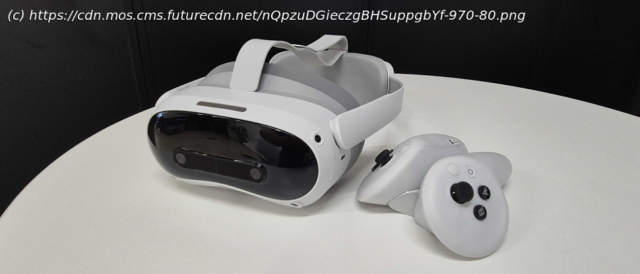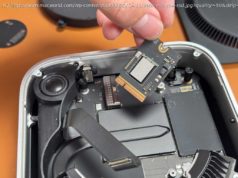The best mid-range VR headset that isn’t made by Meta
Pico 4 Ultra: Two minute review
The Pico 4 Ultra is giving me serious deja vu, and it’s not entirely the good kind.
That’s because its launch is extremely reminiscent of its predecessor; the base Pico 4. A Meta Quest VR headset is the dominant force in the budget/mid range market (then the Meta Quest 2, now the Meta Quest 3), and Pico is launching a device with better specs at an only marginally higher price.
In this instance, the Pico 4 Ultra will net you the Qualcomm Snapdragon XR2 Gen 2 chipset, 256GB of storage, and 12GB of RAM for £529 (around $695 / AU$1025). Meanwhile, the Meta Quest 3 ($499.99 / £479.99 / AU$799.99) only boasts 128GB of storage and 8GB of RAM with the same chipset.
But despite that additional oomph, the Pico 4 Ultra (like the Pico 4 before it) is let down by a lack of software with which to demonstrate its hardware superiority.
With Meta picking up more and more hard-hitting exclusives that you can’t play on Pico systems – including entries in major gaming franchises like Assassin’s Creed and the Batman Arkham series – the severe lack of return fire from Pico is disappointing. Couple that with Meta’s superb OS support and optimizations which the Pico operating system isn’t matching (at least right now) and it’s clear the Pico 4 Ultra isn’t winning in every area – and software-wise the fight isn’t even close.
The Pico 4 Ultra does, however, have a few unique features that could entice you and software developers to pay it some respect.
The first is its spatial footage capture. While it is inconvenient and something of a useless novelty in practice, if a few OS updates can bring some quality improvements this tool could be a fun one for recording memories or creating an experimental stereoscopic film (if you’re willing to put in the effort) without needing to buy an iPhone 15 Pro or Apple Vision Pro.
More importantly it has Meta Connect, a free Virtual Desktop alternative that allows you to connect to your PC wirelessly or use a compatible USB-C cable for productivity and PCVR gaming. In my testing it worked very well and seems a little more feature rich and reliable than Meta’s free Air Link.
Last but by no means least are the Pico 4 Ultra’s standout Motion Trackers. Annoyingly, you have to pay extra for them, but these foot trackers bring a great level of immersion to compatible apps for only £79 (around $100 / AU$150) for a pair – or a lot less if you pick up the preorder bundle or a different deal that I’m sure we’ll see during future sales events like Black Friday. These alone could be the best reason to pick up the Pico 4 Ultra.Pico 4 Ultra: SpecsPico 4 Ultra review: Price and Availability
The Pico 4 Ultra has only one model (the specs are listed above, but the notable stats are 12GB of RAM and 256GB of storage) and it goes on sale in the UK on September 20 for £529 (around $695 / AU$1025). No Australia or US launch has yet been announced.
Preorders go live on September 6 and if you preorder the Ultra you’ll get a few free goodies; namely two free motion trackers (more on those in the Features section) as well as four games:
Blade & Sorcery: Nomad
Infinite Inside
Let’s Get Fit VR
FootPool
The lack of a truly global launch schedule isn’t unheard of for Pico – the original Pico 4 still isn’t available in the US – but it’s always a surprise to see Pico’s headsets dodge a major market, especially this time when the Ultra boasts such impressive internals. Yes, it’s a little pricier than a Meta Quest 3 ($499.99 / £479.99 / AU$799.99) but offers an additional 4GB of RAM and 128GB of storage which is an upgrade that could entice a lot of VR users; that is, if they weren’t locked out because the Pico 4 Ultra is unavailable in their part of the world.
Value score: 4/5 Pico 4 Ultra review: Performance
Every VR game and app runs smoothly
Nothing feels like it needs 12GB of RAM
The Pico 4 Ultra boasts some fantastic hardware upgrades over its predecessor, which help it deliver a stronger performance in VR and MR. The principal upgrades are to its chipset with the Ultra relying on Qualcomm’s Snapdragon XR2 Gen 2 chipset (instead of the Gen 1 like the regular Pico 4) and 12GB of RAM (up from 8GB).
When testing the headset with a good mixture of games – Infinite Inside, Arizona Sunshine 2, All-In-One Sports VR, and Angry Birds VR – everything ran smoothly and looked good on the new device.
There were no hiccups in mixed reality either. Infinite Inside jumps between MR and VR while Angry Birds VR offers a dedicated MR mode for all of its levels. Both titles ran really well in this blended real-and-virtual setting – even when large chain reactions in Angry Birds sent pigs and many blocks that formerly made up their structures flying in different directions.
Now it’s officially announced, with any luck we should see some next-gen upgrades make their way to Pico 4 Ultra games and apps too – just like we saw with Quest 3 titles when Meta’s Quest line made the jump to the XR 2 Gen 2.
My only concern so far is I feel I’ve yet to experience anything that pushes the Pico 4 Ultra in a way which warrants that extra 4GB of RAM over other mid-range VR headsets with an XR2 Gen 2 chipset which only have 8GB (i.e. the Quest 3). Games and apps on those rival systems also run really well, and if Pico is asking us to pay more than its rivals charge because of the Ultra’s improvements, I’d like to see some really concrete reasons why that higher RAM and price is worthwhile.
Hopefully, some made for Pico 4 Ultra software will highlight how necessary the upgrades are, though we’ll have to wait and see what’s announced. For now we can at least enjoy the very solid mid-range headset Pico has delivered.
Performance score: 5/5 Pico 4 Ultra review: Design
Counterbalanced design is appreciated for comfort
No silicon facial interface in the box
The Pico 4 Ultra (unsurprisingly) takes plenty of design cues from the base Pico 4; so much so you might assume they’re the same device at a glance. The Ultra is almost the same weight (580g instead of 586g), features more prominent mixed-reality sensors, and its controllers have lost their icon spiral tracking ring – in favor of the Quest 3 handsets’ tracking ring-less design.
Home
United States
USA — software Pico 4 Ultra review: powerful, but second fiddle to the Meta Quest...






